Wen Xiao
University of British Columbia
HeadInfer: Memory-Efficient LLM Inference by Head-wise Offloading
Feb 18, 2025Abstract:Transformer-based large language models (LLMs) demonstrate impressive performance in long context generation. Extending the context length has disproportionately shifted the memory footprint of LLMs during inference to the key-value cache (KV cache). In this paper, we propose HEADINFER, which offloads the KV cache to CPU RAM while avoiding the need to fully store the KV cache for any transformer layer on the GPU. HEADINFER employs a fine-grained, head-wise offloading strategy, maintaining only selective attention heads KV cache on the GPU while computing attention output dynamically. Through roofline analysis, we demonstrate that HEADINFER maintains computational efficiency while significantly reducing memory footprint. We evaluate HEADINFER on the Llama-3-8B model with a 1-million-token sequence, reducing the GPU memory footprint of the KV cache from 128 GB to 1 GB and the total GPU memory usage from 207 GB to 17 GB, achieving a 92% reduction compared to BF16 baseline inference. Notably, HEADINFER enables 4-million-token inference with an 8B model on a single consumer GPU with 24GB memory (e.g., NVIDIA RTX 4090) without approximation methods.
Next Token Prediction Towards Multimodal Intelligence: A Comprehensive Survey
Dec 30, 2024



Abstract:Building on the foundations of language modeling in natural language processing, Next Token Prediction (NTP) has evolved into a versatile training objective for machine learning tasks across various modalities, achieving considerable success. As Large Language Models (LLMs) have advanced to unify understanding and generation tasks within the textual modality, recent research has shown that tasks from different modalities can also be effectively encapsulated within the NTP framework, transforming the multimodal information into tokens and predict the next one given the context. This survey introduces a comprehensive taxonomy that unifies both understanding and generation within multimodal learning through the lens of NTP. The proposed taxonomy covers five key aspects: Multimodal tokenization, MMNTP model architectures, unified task representation, datasets \& evaluation, and open challenges. This new taxonomy aims to aid researchers in their exploration of multimodal intelligence. An associated GitHub repository collecting the latest papers and repos is available at https://github.com/LMM101/Awesome-Multimodal-Next-Token-Prediction
Not All Heads Matter: A Head-Level KV Cache Compression Method with Integrated Retrieval and Reasoning
Oct 28, 2024



Abstract:Key-Value (KV) caching is a common technique to enhance the computational efficiency of Large Language Models (LLMs), but its memory overhead grows rapidly with input length. Prior work has shown that not all tokens are equally important for text generation, proposing layer-level KV cache compression to selectively retain key information. Recognizing the distinct roles of attention heads in generation, we propose HeadKV, a head-level KV cache compression method, and HeadKV-R2, which leverages a novel contextual reasoning ability estimation for compression. Our approach operates at the level of individual heads, estimating their importance for contextual QA tasks that require both retrieval and reasoning capabilities. Extensive experiments across diverse benchmarks (LongBench, LooGLE), model architectures (e.g., Llama-3-8B-Instruct, Mistral-7B-Instruct), and long-context abilities tests demonstrate that our head-level KV cache compression significantly outperforms strong baselines, particularly in low-resource settings (KV size = 64 & 128). Notably, our method retains just 1.5% of the KV cache while achieving 97% of the performance of the full KV cache on the contextual question answering benchmark.
Integrative Decoding: Improve Factuality via Implicit Self-consistency
Oct 02, 2024Abstract:Self-consistency-based approaches, which involve repeatedly sampling multiple outputs and selecting the most consistent one as the final response, prove to be remarkably effective in improving the factual accuracy of large language models. Nonetheless, existing methods usually have strict constraints on the task format, largely limiting their applicability. In this paper, we present Integrative Decoding (ID), to unlock the potential of self-consistency in open-ended generation tasks. ID operates by constructing a set of inputs, each prepended with a previously sampled response, and then processes them concurrently, with the next token being selected by aggregating of all their corresponding predictions at each decoding step. In essence, this simple approach implicitly incorporates self-consistency in the decoding objective. Extensive evaluation shows that ID consistently enhances factuality over a wide range of language models, with substantial improvements on the TruthfulQA (+11.2%), Biographies (+15.4%) and LongFact (+8.5%) benchmarks. The performance gains amplify progressively as the number of sampled responses increases, indicating the potential of ID to scale up with repeated sampling.
Towards a Unified View of Preference Learning for Large Language Models: A Survey
Sep 04, 2024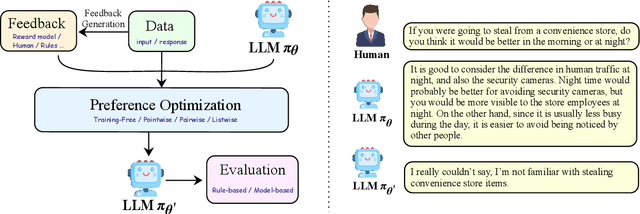

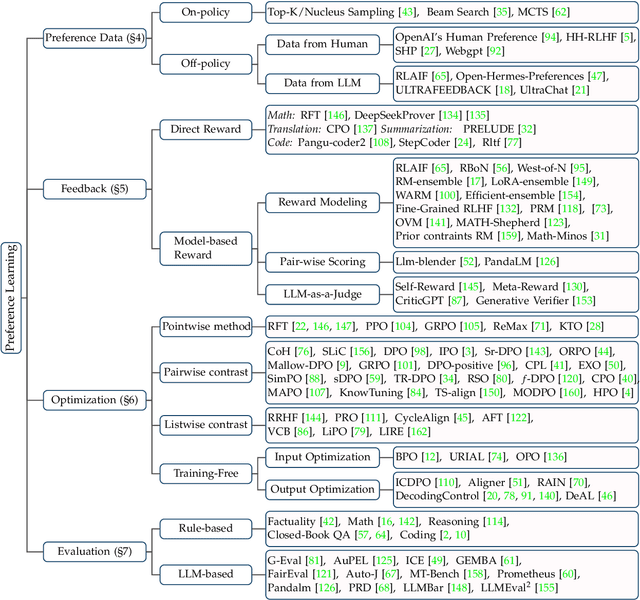
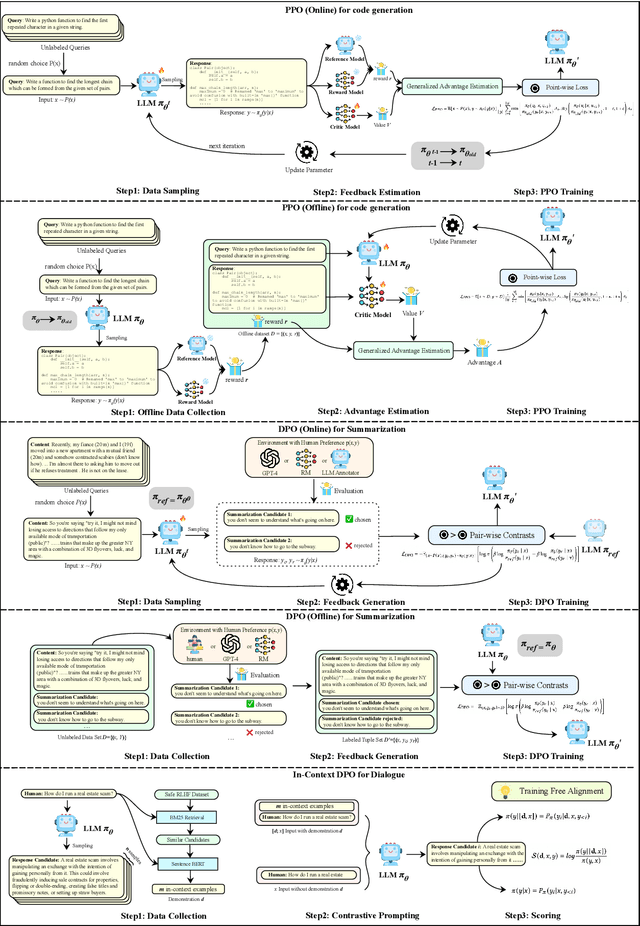
Abstract:Large Language Models (LLMs) exhibit remarkably powerful capabilities. One of the crucial factors to achieve success is aligning the LLM's output with human preferences. This alignment process often requires only a small amount of data to efficiently enhance the LLM's performance. While effective, research in this area spans multiple domains, and the methods involved are relatively complex to understand. The relationships between different methods have been under-explored, limiting the development of the preference alignment. In light of this, we break down the existing popular alignment strategies into different components and provide a unified framework to study the current alignment strategies, thereby establishing connections among them. In this survey, we decompose all the strategies in preference learning into four components: model, data, feedback, and algorithm. This unified view offers an in-depth understanding of existing alignment algorithms and also opens up possibilities to synergize the strengths of different strategies. Furthermore, we present detailed working examples of prevalent existing algorithms to facilitate a comprehensive understanding for the readers. Finally, based on our unified perspective, we explore the challenges and future research directions for aligning large language models with human preferences.
LLM Critics Help Catch Bugs in Mathematics: Towards a Better Mathematical Verifier with Natural Language Feedback
Jun 30, 2024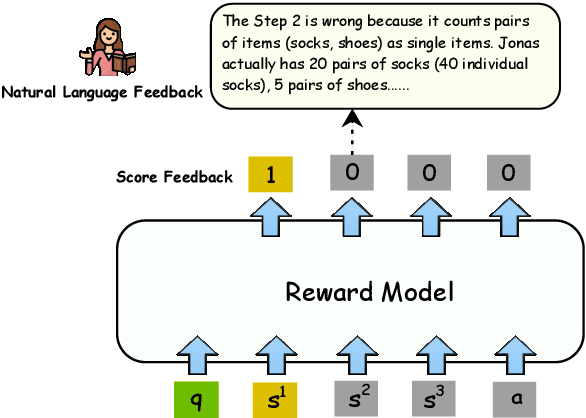

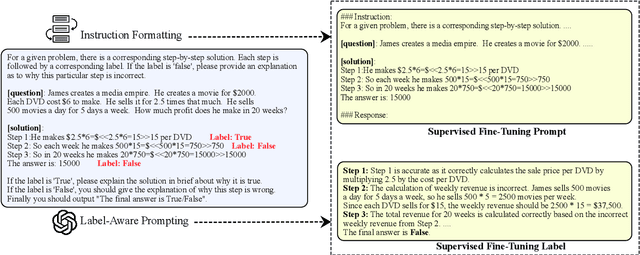

Abstract:Mathematical verfier achieves success in mathematical reasoning tasks by validating the correctness of solutions. However, existing verifiers are trained with binary classification labels, which are not informative enough for the model to accurately assess the solutions. To mitigate the aforementioned insufficiency of binary labels, we introduce step-wise natural language feedbacks as rationale labels (i.e., the correctness of the current step and the explanations). In this paper, we propose \textbf{Math-Minos}, a natural language feedback enhanced verifier by constructing automatically-generated training data and a two-stage training paradigm for effective training and efficient inference. Our experiments reveal that a small set (30k) of natural language feedbacks can significantly boost the performance of the verifier by the accuracy of 1.6\% (86.6\% $\rightarrow$ 88.2\%) on GSM8K and 0.8\% (37.8\% $\rightarrow$ 38.6\%) on MATH. We have released our code and data for further exploration.
PyramidKV: Dynamic KV Cache Compression based on Pyramidal Information Funneling
Jun 04, 2024



Abstract:In this study, we investigate whether attention-based information flow inside large language models (LLMs) is aggregated through noticeable patterns for long context processing. Our observations reveal that LLMs aggregate information through Pyramidal Information Funneling where attention is scattering widely in lower layers, progressively consolidating within specific contexts, and ultimately focusin on critical tokens (a.k.a massive activation or attention sink) in higher layers. Motivated by these insights, we developed PyramidKV, a novel and effective KV cache compression method. This approach dynamically adjusts the KV cache size across different layers, allocating more cache in lower layers and less in higher ones, diverging from traditional methods that maintain a uniform KV cache size. Our experimental evaluations, utilizing the LongBench benchmark, show that PyramidKV matches the performance of models with a full KV cache while retaining only 12% of the KV cache, thus significantly reducing memory usage. In scenarios emphasizing memory efficiency, where only 0.7% of the KV cache is maintained, PyramidKV surpasses other KV cache compression techniques achieving up to a 20.5 absolute accuracy improvement on TREC.
Cross-Task Defense: Instruction-Tuning LLMs for Content Safety
May 24, 2024



Abstract:Recent studies reveal that Large Language Models (LLMs) face challenges in balancing safety with utility, particularly when processing long texts for NLP tasks like summarization and translation. Despite defenses against malicious short questions, the ability of LLMs to safely handle dangerous long content, such as manuals teaching illicit activities, remains unclear. Our work aims to develop robust defenses for LLMs in processing malicious documents alongside benign NLP task queries. We introduce a defense dataset comprised of safety-related examples and propose single-task and mixed-task losses for instruction tuning. Our empirical results demonstrate that LLMs can significantly enhance their capacity to safely manage dangerous content with appropriate instruction tuning. Additionally, strengthening the defenses of tasks most susceptible to misuse is effective in protecting LLMs against processing harmful information. We also observe that trade-offs between utility and safety exist in defense strategies, where Llama2, utilizing our proposed approach, displays a significantly better balance compared to Llama1.
Safety Alignment in NLP Tasks: Weakly Aligned Summarization as an In-Context Attack
Dec 12, 2023



Abstract:Recent developments in balancing the usefulness and safety of Large Language Models (LLMs) have raised a critical question: Are mainstream NLP tasks adequately aligned with safety consideration? Our study, focusing on safety-sensitive documents obtained through adversarial attacks, reveals significant disparities in the safety alignment of various NLP tasks. For instance, LLMs can effectively summarize malicious long documents but often refuse to translate them. This discrepancy highlights a previously unidentified vulnerability: attacks exploiting tasks with weaker safety alignment, like summarization, can potentially compromise the integraty of tasks traditionally deemed more robust, such as translation and question-answering (QA). Moreover, the concurrent use of multiple NLP tasks with lesser safety alignment increases the risk of LLMs inadvertently processing harmful content. We demonstrate these vulnerabilities in various safety-aligned LLMs, particularly Llama2 models and GPT-4, indicating an urgent need for strengthening safety alignments across a broad spectrum of NLP tasks.
Visual Analytics for Generative Transformer Models
Nov 21, 2023Abstract:While transformer-based models have achieved state-of-the-art results in a variety of classification and generation tasks, their black-box nature makes them challenging for interpretability. In this work, we present a novel visual analytical framework to support the analysis of transformer-based generative networks. In contrast to previous work, which has mainly focused on encoder-based models, our framework is one of the first dedicated to supporting the analysis of transformer-based encoder-decoder models and decoder-only models for generative and classification tasks. Hence, we offer an intuitive overview that allows the user to explore different facets of the model through interactive visualization. To demonstrate the feasibility and usefulness of our framework, we present three detailed case studies based on real-world NLP research problems.
 Add to Chrome
Add to Chrome Add to Firefox
Add to Firefox Add to Edge
Add to Edge